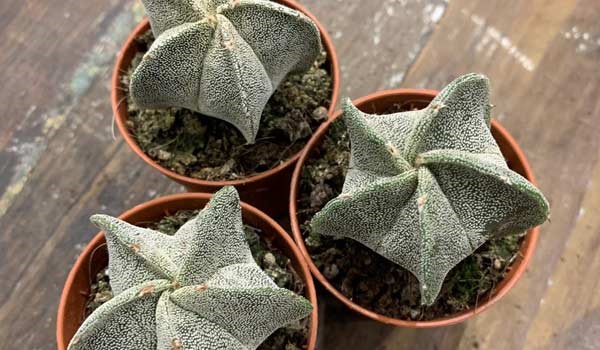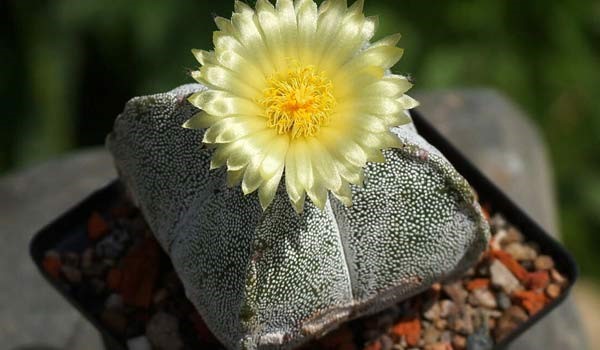Astrophytum Myriostigma (Bishop’s Cap Cactus) Complete Guide

Astrophytum myriostigma is one of those cacti that no succulent can resist buying. Even if we forget about its lovely flower, this star-shaped cacti offers a beautiful combination of beautiful and hardy. This decorative plant is also known as bishop’s cap cactus, bishop’s hat, bishop’s hood, bishop’s miter cactus, or simply star cacti.
This plant gets its botanical/scientific name (astrophytum myriostigma which it is read like (ass-tro-FY-tum MEE-ree-oh-STIG-mah) from its shape; as astrophytum means star plant in Greek. Also, myriostigma means many dotted, because if you look at the bishop’s cap cactus body closely, you will see many light-colored dots.
In the following article, we are going to cover everything about the bishop’s cap cactus, from describing its features and care tips, to how you can propagate it and its most probable diseases.
Astrophytum Myriostigma Look & Features
Like many other beautiful succulents, bishop’s hat also originates in northern and central Mexico. Belonging to Astrophytum genus, this spineless cactus can grow up to more than 3 feet (100 cm) in height and about 8 inches (20 cm) in diameter.
As you can see in all images from these specimen, the most eye-catching feature of the bishop’s cap cactus is its pronounced vertical ribs or stems. Normally they have 5 ribs, but any number from 3 to 8 is also a possibility; the number may increase as the plant ages. The good news is that these ribs have no spikes.
When growing in the wild, bishop’s miter cactus’s globular-shaped stems are covered with white trichomes. However, some astrophytum myriostigma varieties may not have these dots.
Astrophytum Myriostigma Flower
Another considerable aspect of this succulent’s beauty is its flower. When growing in its natural habitat, the striking flowers appear in early spring so that the seeds can grow later under the summer rains. When cultivating, astrophytum myriostigma flower may bloom in the summer. In both cases, the cacti must be at least 6 years old.
The daisy-like flowers have a faint smell, and bloom at the top of the ribs (sometimes there is just one), growing to up to 2.5 inches (6 cm) in diameter. Their color is a nice creamy white to yellow, and sometimes violet-pink, orange, or red. If they are pollinated, soon they will turn into small and fuzzy fruits with a red color that grow up to 1 inch (2.5 cm) in diameter.

Astrophytum Myriostigma Care
Bishop’s cap cactus is very decorative, so it is natural for many people to buy or grow it in their house. They are also not covered in spikes and are very safe for people who have kids or own pets. Bishop’s hat has no known toxic effects too. However, it should not be consumed.
Here are the requirements of bishop’s miter cactus:
Soil
The best combination to plant this cactus is 25% coarse sand, 25% pumice, and 50% potting soil. Or you can simply use pre-packaged cactus soil. The important thing is that the soil is well-drained, and the pot or the container has drainage holes. Also, spread a layer of sand on the soil surface to protect the cacti neck.
Tip: If you wanted to transplant your astrophytum myriostigma, you can use the mentioned soils, but we recommend waiting until early spring for repotting. And since it has a small root, we recommend using small pots.
Water
As you probably know, the bishop’s hat does not need a lot of water to thrive. Follow the instructions below to water astrophytum myriostigma varieties (onzuka, kikko, etc.):
- From October until March do not water at all.
- From March water sparingly, increase as the temperature rises.
- During the summer water in small amounts while avoiding over-watering.
Light & Temperature
Mature bishop’s cap cactus loves sunlight and warmth, but young ones cannot tolerate direct and strong sunlight well. No matter the age, astrophytum myriostigma grows better in light shade than in the full sun. Actually, it is recommended to avoid placing it in the full sun completely.
Since the bishop’s miter cactus need a winter rest, when the temperature decreases, maintain the temperature below 50 °F to let it rest during winter.
Fertilizer
For feeding, you can use diluted low nitrogen fertilizers every month in summer. Do not fertilize in winter. Remember that do not need a lot of feeding.

Bishop’s Cap Cactus Propagation
Bishop’s hat propagation is almost done exclusively by planting its seed. After getting the seeds from a reputable dealer, or removing fresh seeds from a bishop’s hoodie, here is how to propagate this majestic succulent:
- Fill the pot using well-drained soil (like the ones we mentioned earlier) and lightly press the seed on it.
- Water lightly and keep the soil lightly moist until the seed germinates. During this time, you also need to keep the soil temperature around 78 °F.
- After germinating and moving to individual pots, sprinkle a thin layer of sand on the soil surface.
- Place the young astrophytum myriostigma in a spot with as much light as possible, but away from direct light and high temperatures. These harsh conditions can hurt your delicate bishop’s cap cactus.
Bishop’s Hat Cactus Common Problems
This hardy plant requires minimum grooming and maintenance. However, there are some problems that you should look out for; including:
Mealy Bugs & Scale Insects
If you keep your cacti cool in the winter, it is incredibly resistant to houseplant pests. But if it is hot during its winter rest, mealybugs and scale insects may attack it and you notice brown patches around the base (especially if your astrophytum myriostigma is not young)
If this happened, remove the insects with a toothpick and treat the affected areas using cotton and alcohol.
Brown Patches
As we mentioned, if your bishop’s miter cactus is old, it indicates that insects have attacked your houseplant. But it is young, it is a sign of over-watering and soggy soil.
In such conditions, do not water the plant and place it in a tray full of water for 30 minutes. The sand layer that we mentioned before also helps to avoid this problem.
Root Rot
This problem may be the most common one among astrophytum myriostigma varieties. To avoid root rot, simply avoid over-watering and do not place it in a spot that has high humidity.
- In this post:
- Astrophytum Myriostigma Look & Features
- Astrophytum Myriostigma Care
- Bishop’s Cap Cactus Propagation
- Bishop’s Hat Cactus Common Problems



